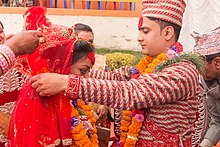Inter-caste marriage in Nepal

Inter-caste marriage (Nepali: अन्तरजातीय विवाह pronounced [ʌntaɾd͡zatie bibaː]) is a type of marriage that is done outside of one's caste. Nepal has many castes and inter-caste marriage is generally considered taboo. However, this kind of marriage has been gradually gaining acceptance.
It is against the law to discriminate against a person for their "cultural and ethnic" background.[1] Nevertheless, most Nepali families disapprove of inter-caste marriages because "they fear they will become social outcasts".[1] According to research done by Jagaran Media Center, inter-caste marriage often leads to harassment, forced separation, displacement, and institutional discrimination.[2] Additionally, brides who are not accepted by their families were found to be at risk of depression and psychosocial difficulties.[3]
Background and reactions
In 1854, the Government of Nepal passed the "Muluki Ain" commissioned by
In 2009, the Government of Nepal announced that it would give a sum of रू100,000 Nepalese rupees (roughly US$1,350[10]) away to couples who have an inter-caste marriage.[11] The recipients would have to claim the sum within 30 days of the marriage.[11] Republica, however, has reported that there was no "government assistance for Dalit women" who were left jilted by their upper-caste husbands.[11]
Notable incidents
2004 Saptari kidnapping
In January 2004, Manoj Khanga, a member of the Dalit community, and Parbati Raut, who were in an inter-caste wedding, were reportedly kidnapped by the bride's relatives.[12] Prior to that, the bride's family had filed a complaint in the police claiming that it the marriage was illegal. The couple were arrested but were released a few days later.[13] Subsequently, the Dalit community living in Saptari District, Nepal, was attacked by over 200 upper-caste people and were compelled to leave their village.[12] All of the property owned by Dalit communities was looted and vandalised (worth about est. 15 million Nepalese rupees).[12] The upper-caste community terrorized and told Khanga that they would "kill him in front of his family".[14] The case was sent to the Asian Human Rights Commission.[12]
Soti incident

In May 2020,
Notable inter-caste marriages
Inter-caste marriage in film
- Pandra Gate (1986), starring Hari Bansha Acharya and Sharmila Malla[22]
- Bato Muni Ko Phool (2010), starring Rekha Thapa and Yash Kumar.[23]
- Ghampani (2017), starring Dayahang Rai and Keki Adhikari[24]
Inter-caste marriage in literature
- B. P. Koirala[25]
See also
References
- ^ from the original on 24 June 2020. Retrieved 24 June 2020.
- ^ "Inter-caste Marriages In Nepal Face Violence And Intimidation" (PDF). The Advocacy Project. Retrieved 27 June 2020.
- ISBN 978-1-137-58672-8.
- ^ from the original on 24 June 2020. Retrieved 24 June 2020.
- ^ "Nepali Politics And The Rise of Jang Bahudur Rana, 1830–1857" (PDF). ProQuest. Retrieved 25 June 2020.
- ^ "Abrogation of Some Criminal Cases and Remission of Punishment Act, 2020 (1963)". Nepal Law Commission. Retrieved 25 June 2020.
- ISBN 978-0-429-75615-3. Archivedfrom the original on 24 June 2020. Retrieved 24 June 2020.
- ISBN 978-1-317-35390-4. Archivedfrom the original on 24 June 2020. Retrieved 24 June 2020.
- ^ "Nepal, an emerging rainbow nation". Nepali Times. Archived from the original on 11 March 2018. Retrieved 24 June 2020.
- ^ "Inter-caste Newlyweds Face Eviction, Discrimination in Nepal". Global Press Journal. 10 August 2010. Archived from the original on 24 June 2020. Retrieved 24 June 2020.
- ^ a b c Sunar, Giri Bahadur. "Rough road to inter-caste marriage". My Republica. Retrieved 24 June 2020.
- ^ a b c d "NEPAL: The Dalit community in Saptari district was attacked due to an inter-caste marriage and the couple was kidnapped". Asian Human Rights Commission. Archived from the original on 24 June 2020. Retrieved 24 June 2020.
- ^ "International Covenant on Civil and Political Rights" (PDF). TreatyBody Internet. Archived (PDF) from the original on 24 June 2020. Retrieved 24 June 2020.
- ^ "Nepal: violence against Dalits because of an inter-caste marriage". World Organisation Against Torture. Archived from the original on 24 June 2020. Retrieved 24 June 2020.
- ^ a b "Soti Incident: 15 including ward chair arrested in connection with Nawaraj BK's killing". The Himalayan Times. 26 May 2020. Archived from the original on 28 May 2020. Retrieved 24 June 2020.
- ^ "Bodies of two Dalit men recovered from Bheri River". kathmandupost.com. Archived from the original on 28 May 2020. Retrieved 24 June 2020.
- ^ "One more body recovered from the Bheri River on Monday". kathmandupost.com. Archived from the original on 28 May 2020. Retrieved 24 June 2020.
- ^ "UN calls for impartial investigation into Rukum (West) incident in which Dalit youths were killed". kathmandupost.com. Archived from the original on 28 May 2020. Retrieved 24 June 2020.
- ^ "Caste no bar". Nepali Times. Retrieved 25 June 2020.
- ^ "Unifying Nepal via Marriage: Pahade Wives and Madhesi Hubbies". 2 August 2007.
- ^ "Oli's Radhika". The annapurna express. 7 May 2018. Retrieved 20 July 2020.
- ^ "Does blackface have a place in Nepali comedy? Probably not". Retrieved 29 June 2020.
- ^ "Batomuniko Phool (A flower under the trail), a must see movie for social reformer". Nepal Dalit Info. Archived from the original on 31 October 2011. Retrieved 25 June 2020.
- ^ "Inter-caste romance in Ghaampani". My Republica. Retrieved 25 June 2020.; "Ghampani collects Rs 12 m in 3 days". My Republica. Retrieved 25 June 2020.
- ISSN 2350-8922.
